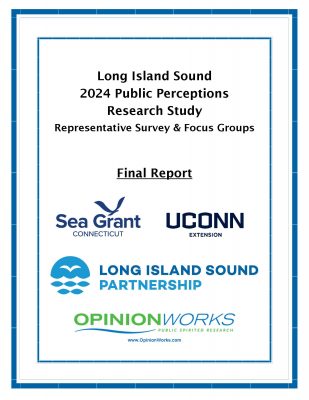
A survey of more than 3,700 Connecticut and New York residents shows the majority view Long Island Sound as a major asset to the quality of life and economy of the region.
The survey by Connecticut Sea Grant on behalf of the Long Island Sound Partnership was conducted in 2024, 18 years after the first public perceptions survey of the estuary was completed. Survey respondents are residents of the Long Island Sound (LIS) watershed—the land area that drains into the estuary—who are a representative sample of the regional population. Nearly 9 million people live in the LIS watershed.
“General impressions of Long Island Sound are overwhelmingly positive,” said project manager Nancy Balcom, associate director of Connecticut Sea Grant. “Sixty percent of respondents agreed that ‘being near Long Island Sound makes [them] feel peaceful and happier.’ Sixty-one percent said the Sound provides recreational opportunities, 58% said it has a positive economic impact on the region, and 60% would call Long Island Sound ‘a national treasure.’”
 Several questions from the 2006 survey were repeated in 2024 for comparison. For example, they were asked, “From a public health perspective, how safe do you think it is for adults and children to swim in Long Island Sound?” Sixty percent said they view the water as very safe or somewhat safe for swimming, while 26% believe it is somewhat unsafe or very unsafe. While still high from a public health perspective, 26% is an improvement over the approximately 38% who felt that way in 2006. Further, in the 2024 survey, 54% of residents said they felt it is safe to eat fish and shellfish from Long Island Sound, while 25% believe it is unsafe and 21% were not sure. In 2006, about 41% of those surveyed felt it was unsafe to eat the Sound’s fish and shellfish.
Several questions from the 2006 survey were repeated in 2024 for comparison. For example, they were asked, “From a public health perspective, how safe do you think it is for adults and children to swim in Long Island Sound?” Sixty percent said they view the water as very safe or somewhat safe for swimming, while 26% believe it is somewhat unsafe or very unsafe. While still high from a public health perspective, 26% is an improvement over the approximately 38% who felt that way in 2006. Further, in the 2024 survey, 54% of residents said they felt it is safe to eat fish and shellfish from Long Island Sound, while 25% believe it is unsafe and 21% were not sure. In 2006, about 41% of those surveyed felt it was unsafe to eat the Sound’s fish and shellfish.
The earlier survey was undertaken by the Stony Brook University Center of Survey Research for the Long Island Sound Study (recently renamed the Long Island Sound Partnership), a cooperative organization of the U.S. Environmental Protection Agency (EPA), the Connecticut and New York Sea Grant programs and multiple state agencies and nonprofits focused on restoring and caring for the estuary. The partnership celebrated its 40th anniversary on June 20 with the release of an updated Comprehensive Conservation and Management Plan for the Sound.
Including both a survey and four focus groups, the recent survey was managed by Connecticut Sea Grant in conjunction with many local partners and the consulting firm OpinionWorks of Annapolis, Maryland. Funding was provided by the LIS Partnership and EPA.
While respondents to the recent survey expressed positive feelings about the Sound, only one-third were even aware that they live in the LIS watershed.
“There’s still work to be done here to build awareness of location and connection,” said Balcom.
The survey report (https://lispartnership.org/2025/08/2024-public-perception-survey/) shares perceptions on topics ranging from water quality to access, outdoor activities to personal priorities, environmental behaviors to stewardship practices and communication preference. Feedback on renaming the Long Island Sound Study was gathered from the focus group participants.
Among the findings:
- LIS has a positive image in the eyes of the vast majority of residents as a source of recreation and emotional uplift.
- Convenient access remains a challenge.
- Perceptions of water quality are mixed, but many people see it improving, especially in the densely populated western Sound region which for many years was plagued by the low oxygen condition known as hypoxia. Hypoxic events have steadily declined in recent years, largely the result of upgrades in sewage treatment plants that empty into the watershed.
- While most residents understand that the actions of people on land affect the Sound’s health, more work is needed to encourage individual actions that collectively make a positive difference.
“The Long Island Sound Comprehensive Conservation and Management Plan (CCMP) includes a new goal for an Informed and Engaged Public, which focuses on inspiring the public to appreciate, value, and protect Long Island Sound,” said Nicole Tachiki, acting director of the EPA Long Island Sound Office. “Understanding current public perception is the first step in considering how we increase appreciation of the Long Island Sound. These survey results provide a basis for making improvements and assessing our goals.”
The survey release is strategically timed to help guide actions to implement the new CCMP. It will provide ideas for new programming to engage and inform more Connecticut and New York residents living in the LIS watershed and help address identified critical actions outlined in the CCMP that protect and preserve the Sound for all.
This survey sample produces a margin of sampling error of no more than ±1.6% at the 95% confidence level, meaning that if every adult resident of the region had been interviewed, the actual results could be expected to fall within that margin at least 95% of the time.
Connecticut Sea Grant, based at the UConn Avery Point campus in Groton, is one of 34 Sea Grant programs supported by the National Oceanic and Atmospheric Administration in coastal and Great Lakes states that encourage the wise stewardship of our marine resources through research, education, outreach and technology transfer.
More information: Nancy Balcom, Connecticut Sea Grant associate director: Nancy.balcom@uconn.edu